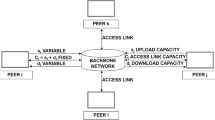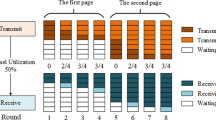Abstract
The great interest in flix-like services has amplified multimedia traffic over the Internet. Recently released traffic forecasting predicts that video-related traffic will be responsible for the majority of Internet traffic by 2022. Such traffic will come in a wide range of duration and in the two modes of live and on-demand. Additionally, it is expected to scale and deliver a smoothed experience to an already fragmented audience. The adaptive bitrate over Hypertext Transfer Protocol (HTTP) has emerged as the top technology for multimedia content transport and delivery. Despite the large amount of work in this area, running streaming applications on overload channels still demands the development of effective strategies. In this work, a video bitrate adaptation mechanism deployed in an overloaded channel of an access network is proposed and evaluated under live and on-demand service modes. This mechanism makes decisions regarding bitrate switching based on the Quality of Experience (QoE)-related parameters to accommodate conflicting variables of its design space, namely, image quality, session continuity and short play time. To evaluate this mechanism, a multifactor QoE metric is proposed based on session parameters such as stalls, startup delay, image quality and the mechanism bitrate misalignment. Moreover, in the numerical studies for the evaluation of the effectiveness of the proposed mechanism, the average video bitrate, instability and fairness are measured. Overall, the proposed mechanism was able to improve the session QoE for both live and on-demand modes.













Similar content being viewed by others
References
Ayad I, Im Y, Keller E, Ha S (2018) A practical evaluation of rate adaptation algorithms in http-based adaptive streaming. Comput Netw 133:90–103. https://doi.org/10.1016/j.comnet.2018.01.019
Bampis C, Bovik A (2018) Feature-based prediction of streaming video qoe: distortions, stalling and memory. Signal Process Image Commun 68:218–228. https://doi.org/10.1016/j.image.2018.05.017
Barman N, Martini MG (2019) QoE modeling for HTTP adaptive video streaming: A survey and open challenges. IEEE Access 7:30831–30859. https://doi.org/10.1109/ACCESS.2019.2901778
Basso S, Servetti A, Masala E, De Martin JC (2014) Measuring dash streaming performance from the end users perspective using neubot. In: Proceedings of the 5th ACM Multimedia Systems Conference, MMSys ’14. https://doi.org/10.1145/2557642.2563671. ACM, pp 1–6
Beben A, Wiśniewski P, Batalla JM, Krawiec P (2016) Abma+: Lightweight and efficient algorithm for http adaptive streaming. In: Proceedings of the 7th International Conference on Multimedia Systems, MMSys ’16. https://doi.org/10.1145/2910017.2910596. ACM, pp 2:1–2:11
Bentaleb A, Taani B, Begen AC, Timmerer C, Zimmermann R (2019) A survey on bitrate adaptation schemes for streaming media over http. IEEE Commun Surv Tutorials 21:562–585. https://doi.org/10.1109/COMST.2018.2862938
Bouraqia K, Sabir E, Sadik M, Ladid L (2020) Quality of experience for streaming services: Measurements, challenges and insights. IEEE Access 8:13341–13361. https://doi.org/10.1109/ACCESS.2020.2965099
Brown MA (2006) Traffic control HOWTO. Accessed: 2021-01-19
Bulkan U, Dagiuklas T (2019) Predicting quality of experience for online video service provisioning. Multimed Tools Appl 78(13). https://doi.org/10.1007/s11042-019-7164-9
Cisco (2018) Cisco visual networking index (vni) complete forecast update, 2017–2022. Accessed: 2021-01-19
Corporation A (2020) HTTP live streaming overview. Accessed: 2021-01-19
Coelho MdS, Melo CAV, da Fonseca NLS (2017) Versioning-aware and qoe-oriented strategy for adaptative bitrate streaming. In: IEEE International Conference on Communications (ICC). https://doi.org/10.1109/ICC.2017.7996743, pp 1–6
ISO/IEC 23009-1:2019 information technology – dynamic adaptive streaming over http (dash) – part 1: Media presentation description and segment formats, 4 edn. International Organization for Standardization/International Electrotechnical Commission, Geneva, Switzerland (2019)
Jiang J, Sekar V, Zhang H (2014) Improving fairness, efficiency, and stability in http-based adaptive video streaming with festive. IEEE/ACM Trans Netw 22:326–340. https://doi.org/10.1109/TNET.2013.2291681
Jiang J, Sun S, Sekar V, Zhang H (2017) Pytheas: Enabling data-driven quality of experience optimization using group-based exploration-exploitation. In: Proceedings of the 14th USENIX Conference on Networked Systems Design and Implementation, NSDI’17. USENIX Association, USA, pp 393–406
Juluri P, Tamarapalli V, Medhi D (2015) Sara: Segment aware rate adaptation algorithm for dynamic adaptive streaming over http. In: 2015 IEEE International Conference on Communication Workshop (ICCW). https://doi.org/10.1109/ICCW.2015.7247436, pp 1765–1770
Juluri P, Tamarapalli V, Medhi D (2016) Measurement of quality of experience of video-on-demand services: A survey. IEEE Commun Surv Tutorials 18:401–418. https://doi.org/10.1109/COMST.2015.2401424
Mao H, Netravali R, Alizadeh M (2017) Neural adaptive video streaming with pensieve. In: Proceedings of the Conference of the ACM Special Interest Group on Data Communication, SIGCOMM ’17. https://doi.org/10.1145/3098822.3098843. ACM, pp 197–210
Murugadoss R, Kumar MMVM (2020) The quality of experience framework for http adaptive streaming algorithm in video streaming over wireless networks. Int J Fut Gener Commun Netw 13:1491–1502
Pantos R, May W (2017) HTTP Live Streaming. RFC 8216. https://doi.org/10.17487/RFC8216
Petrangeli S, Wu T, Wauters T, Huysegems R, Bostoen T, De Turck F (2017) A machine learning-based framework for preventing video freezes in http adaptive streaming. J Netw Comput Appl 94:78–92. https://doi.org/10.1016/j.jnca.2017.07.009
Spiteri K, Urgaonkar R, Sitaraman RK (2016) Bola: Near-optimal bitrate adaptation for online videos. In: IEEE INFOCOM - The 35th Annual IEEE International Conference on Computer Communications. https://doi.org/10.1109/INFOCOM.2016.7524428, pp 1–9
Sun L, Zong T, Liu Y, Wang Y, Zhu H (2019) Optimal strategies for live video streaming in the low-latency regime. In: IEEE 27th International Conference on Network Protocols (ICNP). https://doi.org/10.1109/ICNP.2019.8888127, pp 1–4
Thang TC, Le HT, Pham AT, Ro YM (2014) An evaluation of bitrate adaptation methods for http live streaming. IEEE J Sel Areas Commun 32:693–705. https://doi.org/10.1109/JSAC.2014.140403
Tian G, Liu Y (2016) Towards agile and smooth video adaptation in http adaptive streaming. IEEE/ACM Trans Netw 24:2386–2399. https://doi.org/10.1109/TNET.2015.2464700
Wilk S, Stohr D, Effelsberg W (2016) A content-aware video adaptation service to support mobile video. ACM Trans Multimed Comput Commun Appl 12:82:1–82:23. https://doi.org/10.1145/2983636
Wisniewski P, Batalla JM, Beben A, Krawiec P, Chydzinski A (2017) On optimizing adaptive algorithms based on rebuffering probability. ACM Trans Multimed Comput Commun Appl 13:43:1–43:20. https://doi.org/10.1145/3092837
Funding
This study was financed in part by the Coordenação de Aperfeiçoamento de Pessoal de Nível Superior - Brasil (CAPES) - Finance Code 001 and by the Fundação de Amparo à Pesquisa do Estado do Amazonas - Finance Code 024/2014.
Author information
Authors and Affiliations
Corresponding author
Ethics declarations
Conflicts of Interests
Competing Interests
All authors certify that they have no affiliations with or involvement in any organization or entity with any financial interest or non-financial interest in the subject matter or materials discussed in this manuscript.
Additional information
Publisher’s note
Springer Nature remains neutral with regard to jurisdictional claims in published maps and institutional affiliations.
Rights and permissions
About this article
Cite this article
Coelho, M.S., Melo, C.A.V. & Fonseca, N.L.S.d. An encoding-aware bitrate adaptation mechanism for video streaming over HTTP. Multimed Tools Appl 81, 27423–27451 (2022). https://doi.org/10.1007/s11042-022-12520-z
Received:
Revised:
Accepted:
Published:
Issue Date:
DOI: https://doi.org/10.1007/s11042-022-12520-z




